Great news! Isabella Rotman’s A Quick and Easy Guide to Consent is here to bring us a little desperately needed joy in this hellish year! Isabella is a beloved queer sex educator and cartoonist who is well known for her use of comics as an educational tool. And folks, this one delivers!
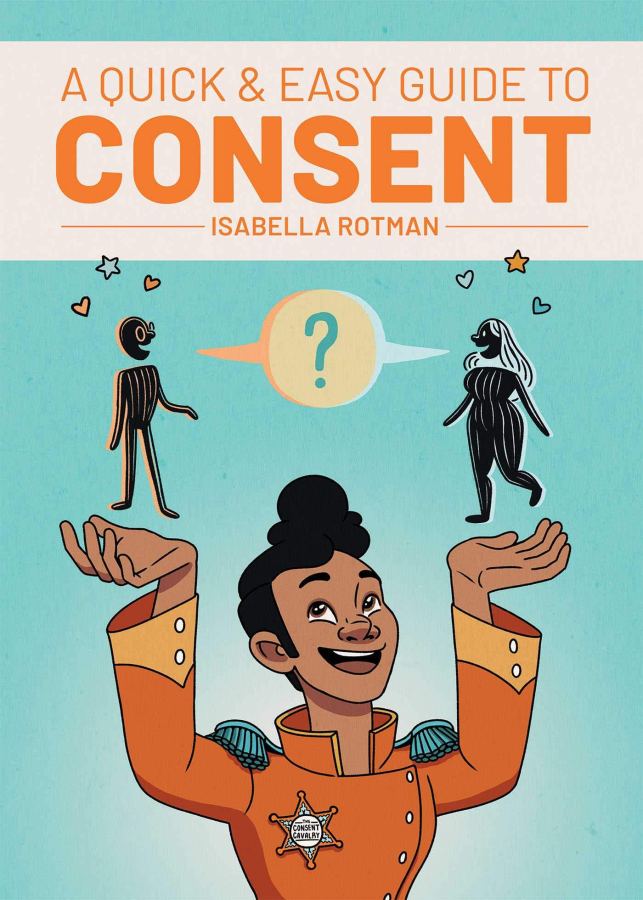
We know (or at least, I hope we know) that communication is a vital part of connecting with other people, but it can feel daunting when we don’t have a clear understanding of how to ask for what we want (and don’t want) for ourselves and our bodies. Isabella’s comic lays out a ground work in understanding consent for those new to the topic and explores different scenarios that may feel more nuanced or less talked about (like sex when we’re drinking, and responding to rejection).
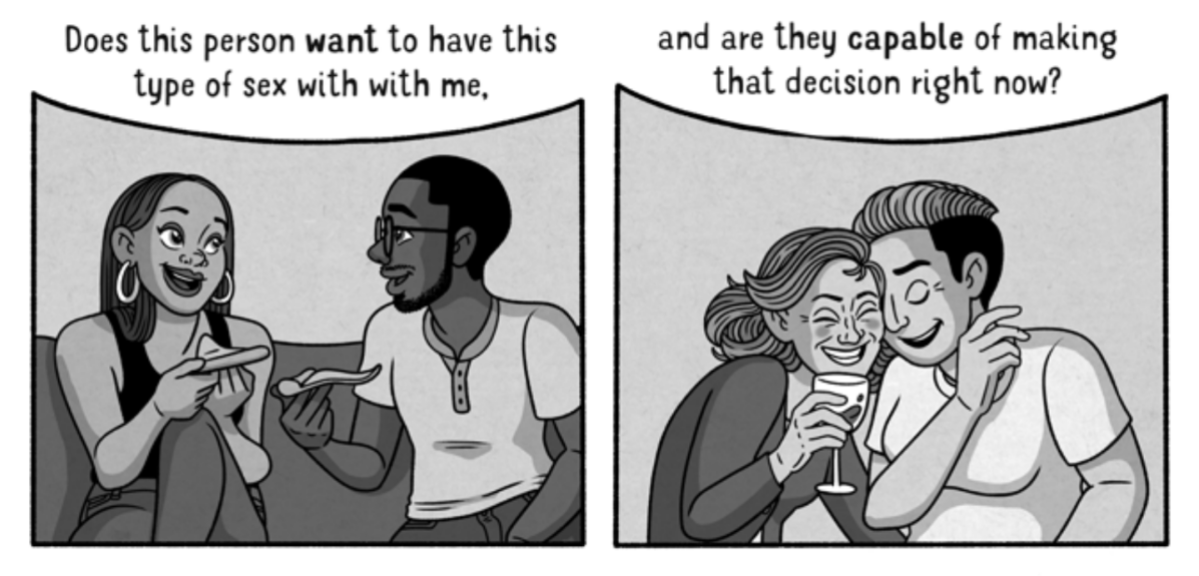
As a queer human living laughing loving out in the world (well—not right now, but, y’know), I fancy myself one to know about the importance of consent. But, beyond the basics of understanding “yes” and “no” there’s still a lot of communication to be had and no matter how much one knows, there’s more to learn. It’s a journey and there are a lot of paths to getting there. Isabella’s guide is an approachable take on the topic that not only explores consent in its broad definition, but gets into the various ways it may show up in our interactions with one another.
You’re likely familiar with Isabella’s work with Scarleteen.com and her sex education comic, You’re so Sexy When You Aren’t Transmitting STIs, as well as her 2019 educational graphic novel with Heather Corinna, Wait, What? A Comic Book Guide to Relationships, Bodies, and Growing Up from Oni Press. Or her incredible This Might Hurt tarot deck! A Quick and Easy Guide to Consent is the next installment of the ongoing and appraised Quick and Easy Guide series from Limerence Press, a set of fun and informative comics exploring topics of sexuality and gender. I personally loved it, and I think you might too!
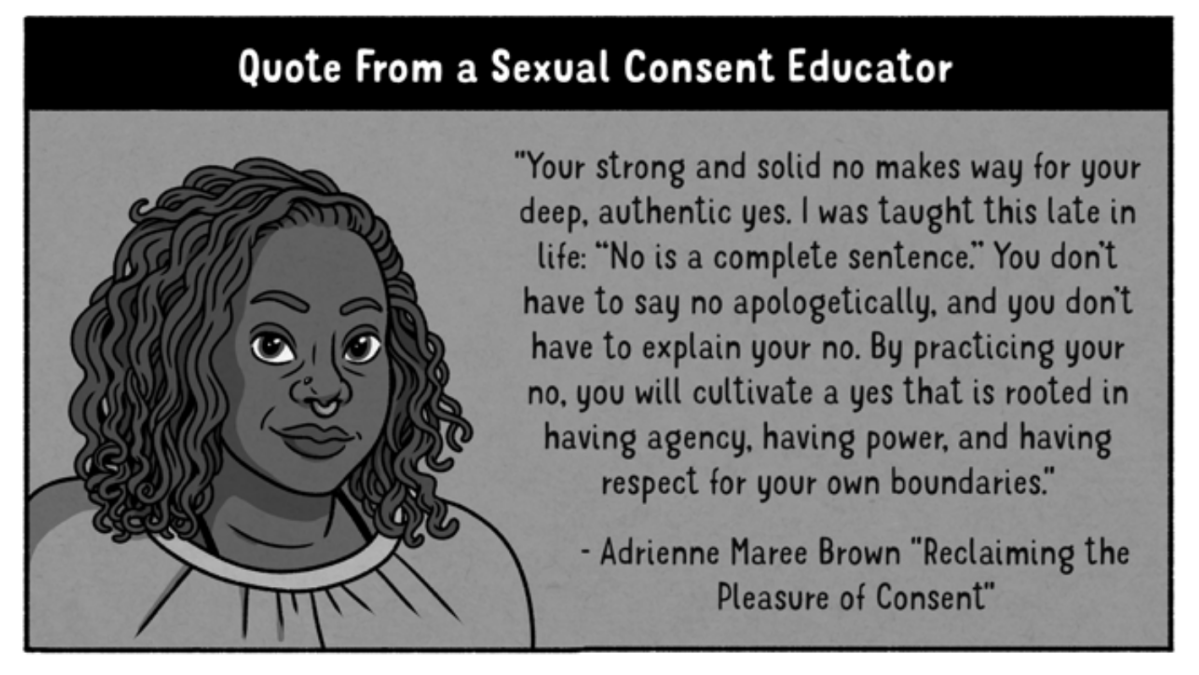
Lucky me got to chat a bit with Isabella on the book and her hopes for it. So saddle up, and enjoy this quick interview!
AA: I was so jazzed to hear that you were creating a Quick & Easy Guide to Consent for the series! Consent often seems to be one of those topics that is featured as a part of the conversation or a chapter of the book, rather than the sole focus. Why do you think it’s important to have a resource like this?
IR: Thanks A! I think consent is and should be the building block of ALL SEX EDUCATION! It is where sex must start, and the state participants need to exist in for the duration of all sexual activity. It’s so important. Additionally, consent is not just about sex. It’s a practice that can and should be applied to all aspects of life that include other people, and the skills discussed in this book can be applied to so many interpersonal interactions. Whether you are consenting to sex or COVID-19 precautions, the skills are the same.
Why do I think a book that is entirely about sexual consent is important? Well, I’m not sure that it is. What’s important is that consent is the building block of sex education. I’ve seen lots of sex educators do this by building on consent as a chapter of a larger book, and this is okay. In my first ex ed book consent was covered in 4 pages. The core concept of consent is simple, and doesn’t take long to get across. All confusing variables can be parsed out by returning to the core concept.
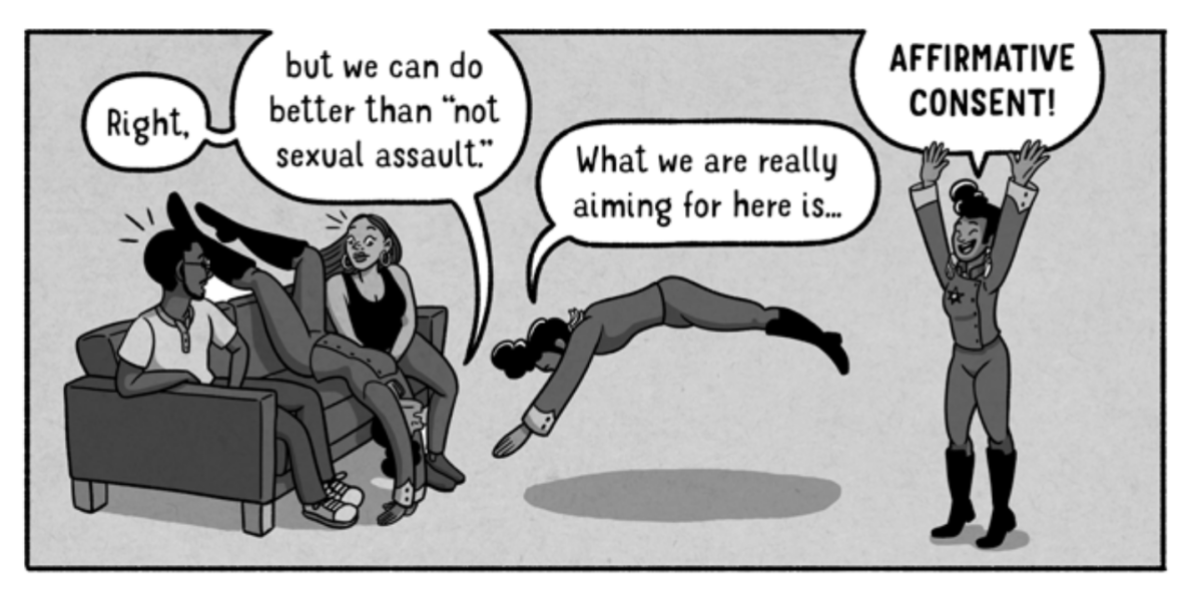
The reason I was excited to write a book solely about consent is that it gave me the room and opportunity to follow the thread of many of these confusing variables and demonstrate how consent can be practiced by returning to this core concept. I’ve never had the opportunity to model so many responses to so many situations. I think it makes the core concept much stronger, to see how it holds up in various circumstances. I’m excited to see how sex educators might use this book as part of larger sex education curriculums, because while I believe sex ed needs to start with consent, there’s still a lot more ground to cover from there!
How do you feel comics lend themselves as tools for sharing educational information?
Comics are such a fantastic educational tool. I think that the combination of words, images, and a narrative improve our ability to learn and remember content. There are educational theories that support this, such as Dual-Coding theory and Social Cognitive Theory, but I’m not an expert on them at all. As I understand it, part of Dual-Coding Theory states that information processing and retention is improved when presented in both text and images, and social cognitive theory states that we learn through direct experiences, but more through social modeling, what we see, read, and hear.
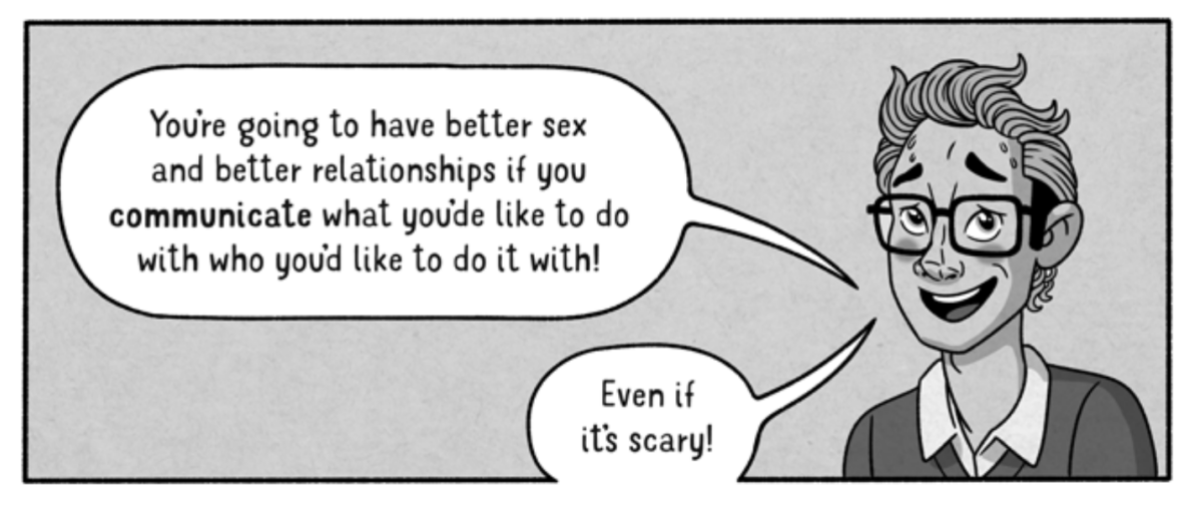
These theories absolutely support how I approach education through comics. I do think people are more likely to retain information if they are learning through a narrative. When you are invested in characters you are just… more invested. I see this in myself and other readers as well. I also love comics for this, because you can draw things without having to say them. I think this is important. Sometimes things feel very corny when they are said, but when they just are, it feels more natural. You can also show one thing while you say another, and both pieces of information are taken in by the reader at the same time. It’s wonderful.
Also, I think comics are innately non-pretentious. Like, you can make a pretentious comic, and people DEFINITELY DO IT, but you kind of have to try. No one wants to learn if they feel they are being talked down to, and I think comics are generally considered low-brow and therefore less likely to make someone feel like they are being lectured at and condescended to.
One of my favorite things about this series, and your guide in particular, is the sharing of complex information in really concise and digestible ways. What did you find to be the biggest challenges and advantages in tackling a big topic like consent while working within a “quick & easy” format?
Well, as I say in the comic, sex, like the people involved in it, is complicated! It can feel like consent is complicated too when we consider all the variables and potential for miscommunication. That being said, I really believe the core concept of consent is simple. In the book I present this core concept as “Does this person want to have sex with me, and are they capable of making that decision right now?” This is a model for consent that I learned from sex educator Emily Nagoski. No matter how complicated all the variables are, if you keep going back to that core concept, and air on the side of communication and caution, consent isn’t hard.
Of course, when writing a whole book on the topic of consent, I do have to address the potential complicating factors. This is where fitting the book into the Quick and Easy format did get challenging. On topics like consent while intoxicated there is certainly a lot to say, but due to the format I did my best to keep it brief and return to the core concept of consent that carries throughout the book.
Can we pleeeease talk about the Consent Calvary?! I love the use of a magical consent guide, where did they come from? What guided your decision to use a fictional guide to walk readers through the narrative?
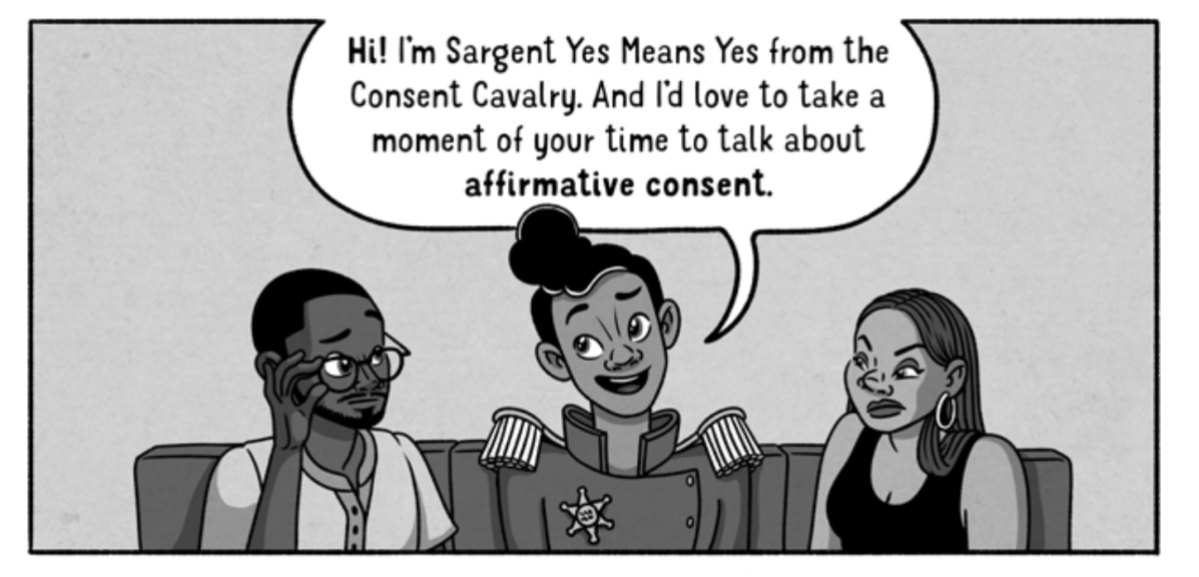
HA! I’m glad you like it! Sergeant Yes Means Yes (Sarge) is a character I created for a previous zine Not On My Watch; The Bystanders’ Handbook for the Prevention of Sexual Violence. Not On My Watch is a self published comic that I created for colleges to distribute to their students. The zine focuses on how bystanders’ can recognize situations involving non-consent and intervene effectively. In the zine Sarge rides in on a bicycle to invite the ‘bystander character’, and by extension the reader, to join the ‘Consent Cavalry’ and vow to intervene in bad situations, abusive relationships, or when people say things that perpetuate a culture that enables sexual violence.
When I wrote the first draft script for A Quick and Easy Guide to Consent I actually created a character version of myself that was a teacher. Sarge wasn’t part of the book, and all their lines were delivered by fictional-me, a lot like the structure of your book A Quick and Easy Guide to Sex & Disability and Archie’s A Quick and Easy Guide to They/Them Pronouns. I ended up having issues with the script because it felt like too much of one character (me) telling all the other characters the right way to do things, with little discussion or learning from each other. I wanted the other characters to add to the conversation, but it felt wrong to put words in fictional me’s mouth that I did not agree with just to have another character improve upon them.
Because of this, I decided to go with a fictional guide instead, and fortunately, I already had Sarge and the Consent Cavalry from my previous book! Making Sarge the guide instead of me gave me more freedom to write Sarge saying things that would then be debated by the other characters. In this way, when I thought there were multiple valid viewpoints on an issue, I was free to have those viewpoints represented in conversation between multiple characters. You can see this most clearly in the section on consent and alcohol, where Sarge says if someone is intoxicated they don’t have the judgement to make clear informed consent, which is a view held strongly by most sex educators. Another character, Susan, who is intoxicated during the conversation, takes issue with the idea that it’s impossible to get tipsy and have consensual sex, which is a view held by… most people who drink. Sarge, Susan, and Susan’s date Kai then discuss the issue together and come to a conclusion about drinking and consent that feels reasonable to all of them.
So, I love Sarge because they aren’t me, and because they’re goofy, and because they listen to the other characters and are willing to work with them to adapt their definition of consent to fit individuals and their relationships. Sarge is also optimistic and really believes that most people are well intentioned, and they mess up sometimes due to being uninformed, out of practice, or acting out of insecurity. Sarge is willing to work with characters who have messed up and believes in their good intentions and ability to learn and improve. I love this about Sarge, and I think this attitude removes some of the judgmental tone that contributes to some people resenting consent education.
I loved, loved, loved the inclusion of coping with rejection (or fear of) in this guide. I sometimes feel like a lot of consent education surrounds seeking out an affirmative yes, but may not touch upon how to deal with it when the response is actually a big ol’ “nope.” Why do you feel this is an important aspect of the consent conversation?
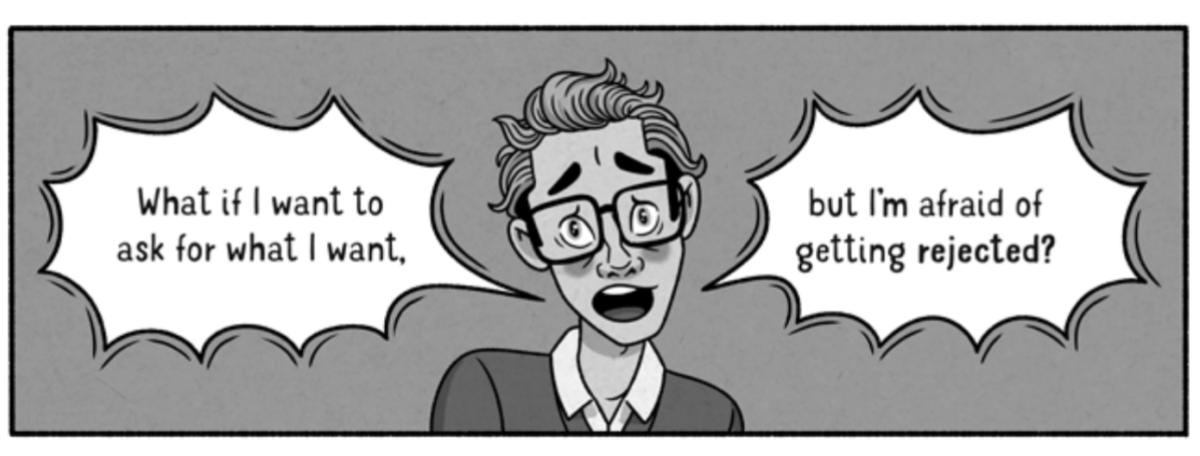
Dealing with rejection is a huge part of consent, and honestly, just a huge part of seeking out and engaging with other human beings in general. Very frequently the response is a big old ‘nope.’ How you react to that nope is so important. Even if you are a person who only wants to have sex with someone who wants to have sex with you, rejection can hurt. Logically we know that when we are rejected, we haven’t lost anything because we never had it. We know we miss all the shots we don’t take, but the loss of the possibility can feel just as bad. It is human nature to react negatively, and dealing with rejection in a healthy way is something many of us have to learn.
So, in A Quick and Easy Guide to Consent, I try to lay it out logically. When someone tells you no, that no means “not that, and not right now.” That’s it. They are not saying that you are a bad person who does not deserve what you asked for. They are not saying they don’t want to do other things with you. Feelings that a no means more than “not that, and not right now” come from our own insecurities, not the other person. Of course, we are humans and we are insecure, so these feelings can be really hard to talk ourselves out of.
What’s important is how you react to the rejection. Everyone has a right to say no to something, especially sex. Even if their ‘reason’ feels bad to you, or they don’t give you a reason at all. You are not entitled to anyone else’s time or body, or even an explanation of why they are not interested. You should accept their answer and respect their boundaries. React with compassion whenever possible! In order for an affirmative yes to matter, a person must know that their ‘no’ will be respected and treated with kindness. If the rejection has hurt you, you can also consider if distance would benefit you, and respectfully set your own boundaries if that’s what’s best for you.
When I was reading A Quick and Easy Guide to Sex and Disabilty, I really loved your section on dealing with rejection! The inclusion of self care when dealing with rejection was wonderful, and made me wish I had put something like that in my book as well. Sometimes the reasons a person is rejected are really terrible, like ableism or cissexism, but a no is a no all the same. All no’s have to be respected. A good reason is not required. In hindsight, I wish I had added a little more content about how to emotionally care for yourself after a rejection like that.
Obviously consent is a topic for anyone and everyone and this little guide covers a lot of ground! But is there a particular audience you feel will most benefit from this resource? What resources would you most recommend for folks who may want to dive in even deeper?
I’d love for this book to reach young people! I think these ideas are important for everyone, but can save you a lot of trouble if learned before you are starting to date and have sex. I’d also really love it if this guide could reach people who haven’t been been provided the comprehensive, consent-focused, and non-judgemental sex education they deserve. Lots of school-based sex education is not consent- or pleasure-focused. Some of it uses fear as an abstinence motivator, which is not the right or even effective way to go about things at all. I really hope that the people who have not gotten their sex education through school, or gotten poor sex education, are able to suppliment it with the Quick and Easy Guides and online resources like Scarleteen.com. This is part of the reason that I am hoping the Quick and Easy Guides end up in a lot of libraries, especially in communities without good sex ed curriculum, because libraries are often the only way teens and young adults are able to access information without parental restrictions or influence. So, thank you librarians! Libraries are so important.
What are your biggest hopes for the book in terms of how it might affect how people think (and talk) about consent? What are you most excited about?
I know I said this, but my biggest hope is that this book reaches people who have not been provided the consent and pleasure focused sex education they deserve from other avenues! I’d love to see the conversation around consent change from ‘scary’ to ‘exciting.’ Consent isn’t a hoop you have to jump through the get sex, and if you are thinking of it that way you really aren’t holding your partners boundaries and desires as equally important and deserving of celebration and respect as your own. Consent should be joyful. It’s not a test, it’s a conversation that will likely make intimacy more enjoyable and empowering for everyone involved.
I wish we could think about talking about sex like we think about ordering a pizza. Pizza is my favorite metaphor for sex.* We are gonna discuss if we even want pizza, and if we do, we will discuss what toppings we want, or if anyone is vegan or gluten-free, and in the end, we are gonna get a pizza that is absolutely the most delicious pizza that everyone involved in the eating the pizza wants right now.
*Pizza metaphor adapted from TED talk by Al Vernaccchio
What’s next for you? Anything you can share?!

Not at the moment! I’m very excited for this book to come out October 27th, and for now I’m just working on some other projects that don’t really have enough substance to discuss yet.
A Quick and Easy Guide to Consent is out October 27th and you can purchase A Quick and Easy Guide to Consent from your local bookstore!
Isabella and I would recommend Moon Palace Books, Women and Children First, or Semicolon Bookstore and Gallery. If you really want to help A out, consider leaving a positive review on Amazon!



((In the main page blurb, it says the book is called ‘A quick and easy guide to sex and disability’ – also a great book, but just a heads up!))
…..And now I’ve bought 2 copies, one to read and then give away and the other to pass on to one of my niblings.
Welcome to Gari Resort, Bangalore – one of the best corporate Team outing resorts in Bangalore that offers a unique blend of luxury, comfort, and relaxation. If you are looking for the perfect escape from the hustle and bustle of city life, Gari Resort is the place for you.